Introduction
Picture yourself drifting on calm waters as coconut palms lean gracefully toward the shore, fishermen glide past in narrow canoes, and birdsong fills the air. This is the magical world of the Kerala backwaters, a place where nature, culture, and tradition come together in perfect harmony. Often referred to as the “Venice of the East,” this network of canals, rivers, lagoons, and lakes spans Kerala’s coastal belt, offering a unique travel experience unlike any other in India.
For centuries, these waterways have been central to the lifestyle of Kerala’s people. They are not just picturesque but also functional, supporting fishing, farming, and trade. Today, they attract travelers from around the globe—honeymooners seeking romance, families seeking cultural immersion, and adventurers eager to explore one of India’s most unique landscapes.
In this guide, we’ll uncover everything you need to know about the Kerala backwaters—their history, cultural importance, the best time to visit Kerala, must-see destinations, the charm of houseboat cruises, suggested Kerala itineraries, practical travel tips, and more. By the end, you’ll have a complete blueprint for planning an unforgettable journey through this enchanting corner of India.
Understanding the Kerala Backwaters
What Exactly Are the Kerala Backwaters?
The backwaters of Kerala are an interconnected system of waterways stretching nearly 900 kilometers. They consist of lagoons, estuaries, canals, rivers, and lakes that run parallel to the Arabian Sea. Unlike fast-flowing rivers, these waters are calm, brackish, and ideal for travel, trade, and exploration.
Geography of the Backwaters
The largest and most iconic part of this network is Vembanad Lake, which spans several districts, including Alleppey and Kumarakom. From here, countless canals branch out to nearby towns and villages. Thin strips of land separate the backwaters from the sea, giving Kerala its distinctive coastal geography.
Cultural Significance
For locals, the backwaters are far more than a tourist attraction—they are a lifeline. Communities rely on them for fishing, agriculture, and daily transport. Villages scattered along the banks thrive on coir production (coconut fiber crafts), toddy tapping, and paddy cultivation, much of which is made possible by the fertile land and easy access to water.
Recognition Worldwide
Kerala’s backwaters are now a symbol of India’s natural beauty and cultural richness. Featured in travel documentaries, award lists, and global tourism campaigns, they have gained worldwide fame. The Kerala houseboat experience, in particular, has become a bucket-list activity for travelers from the USA, Europe, and Asia who dream of floating gently across these serene waters.
History of Kerala Backwaters
Ancient Role in Trade
Long before highways and railways, the Kerala backwaters served as vital routes for commerce. Canoes and cargo boats carried rice, coconuts, and spices between villages and coastal ports. The Kuttanad region, often called the “Rice Bowl of Kerala,” still showcases the deep agricultural ties to these waters.
Colonial Era
During Portuguese, Dutch, and British rule, Kerala’s waterways became important channels for the thriving spice trade. Goods like pepper, cardamom, and cinnamon traveled through these canals before being shipped abroad. European powers even constructed canals and docks to boost trade efficiency.
Rise of Tourism
The traditional Kettuvallam boats, once used to carry rice and spices, were later converted into floating houseboats equipped with bedrooms, kitchens, and lounges. By the late 20th century, these boats became Kerala’s signature tourism experience. Today, spending a night on a houseboat is one of the most popular things to do in India.
Backwaters Today
In modern times, the backwaters remain both a cultural treasure and a tourism hub. Events like the Nehru Trophy Boat Race in Alleppey showcase their importance in Kerala’s heritage. Meanwhile, the state’s tourism board promotes sustainable practices to balance economic growth with environmental preservation.
Best Time to Visit Kerala
Kerala is beautiful throughout the year, but the backwater experience changes with each season. To plan the perfect trip, it’s essential to know the best time to visit Kerala.
Winter (November – February) – The Ideal Season
-
Climate:
-
Pleasant temperatures around 25°C.
-
Why Go:
-
Perfect for houseboat cruises, outdoor sightseeing, and cultural tours.
-
Travel Tip:
-
This is the busiest season, so book houseboats and resorts well in advance.
Summer (March – May) – The Quiet Escape
-
Climate:
-
Hot and humid, with highs of 35°C.
-
Why Go:
-
Fewer crowds and better deals on accommodations. Great time for Ayurveda therapies.
-
Travel Tip:
-
Pack light cotton clothes, sunscreen, and stay hydrated.
Monsoon (June – September) – The Green Season
-
Climate:
-
Heavy rains transform the landscape into lush greenery.
-
Why Go:
-
Best season for Ayurvedic treatments, romantic getaways, and offbeat travel.
-
Travel Tip:
-
Some boat services may be limited, but resorts offer special monsoon packages.
Overall Recommendation
The best time to explore the Kerala backwaters is during winter (Nov–Feb) when the weather is most comfortable. However, budget travelers and wellness seekers may find summer and monsoon equally rewarding.
Places to See in Kerala Backwaters
The Kerala backwaters stretch across a vast network of towns and villages, each offering a unique blend of scenery, history, and cultural traditions. Whether you are looking for luxury resorts, traditional village life, or peaceful retreats, every destination adds something special to your Kerala travel experience.
Alleppey (Alappuzha) – The Venice of the East
Alleppey, also known as Alappuzha, is the most famous hub of the backwaters and is often called the “Venice of the East.” Its maze of canals, lagoons, and lush paddy fields makes it the best place to experience the essence of Kerala.
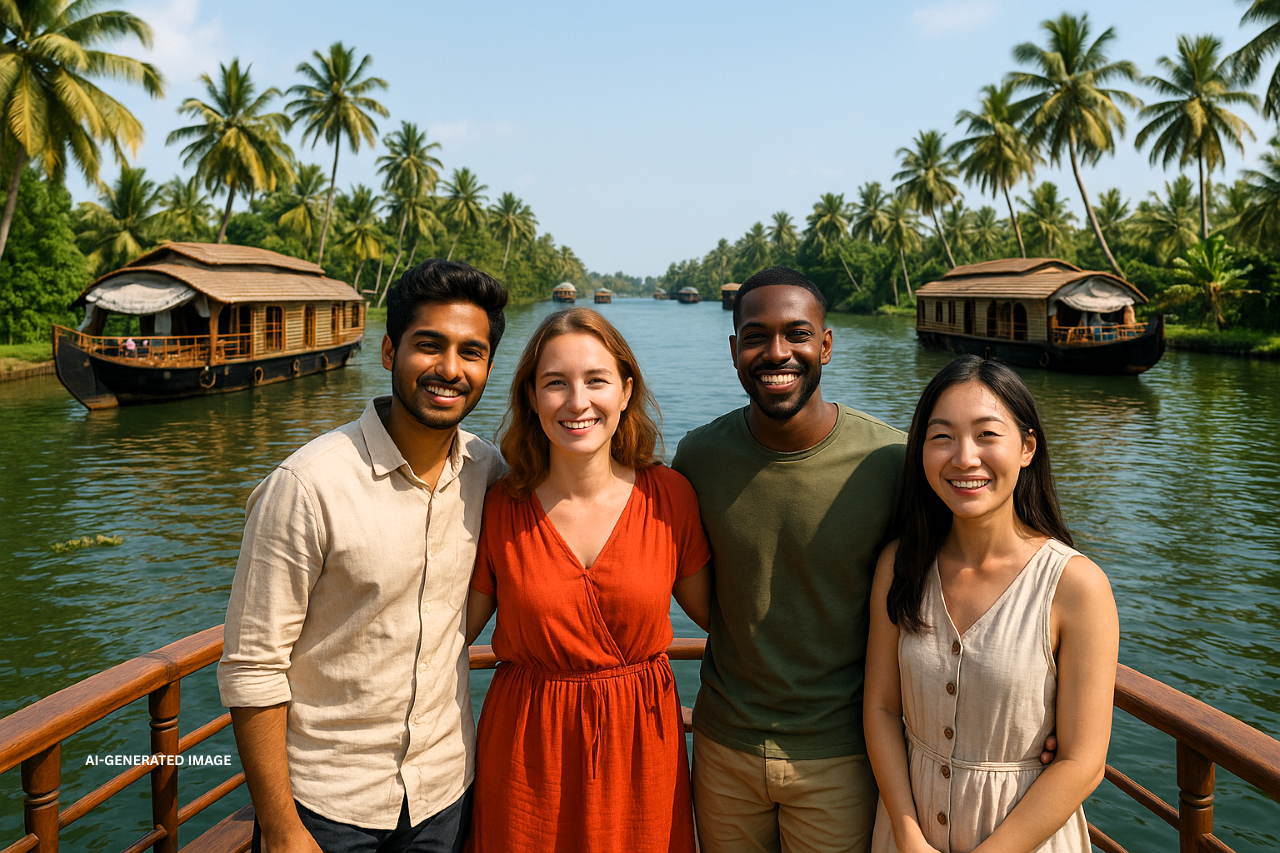
-
Highlights:
-
Overnight cruises on traditional houseboats in Kerala.
-
The thrilling Nehru Trophy Snake Boat Race in August.
-
Golden sunsets at Alleppey Beach.
-
-
Why Visit:
-
Alleppey is the perfect destination for those looking for the classic Kerala backwater experience.
Kumarakom – A Peaceful Escape
Situated on the banks of Vembanad Lake, Kumarakom is a tranquil village renowned for its eco-tourism initiatives and scenic beauty.
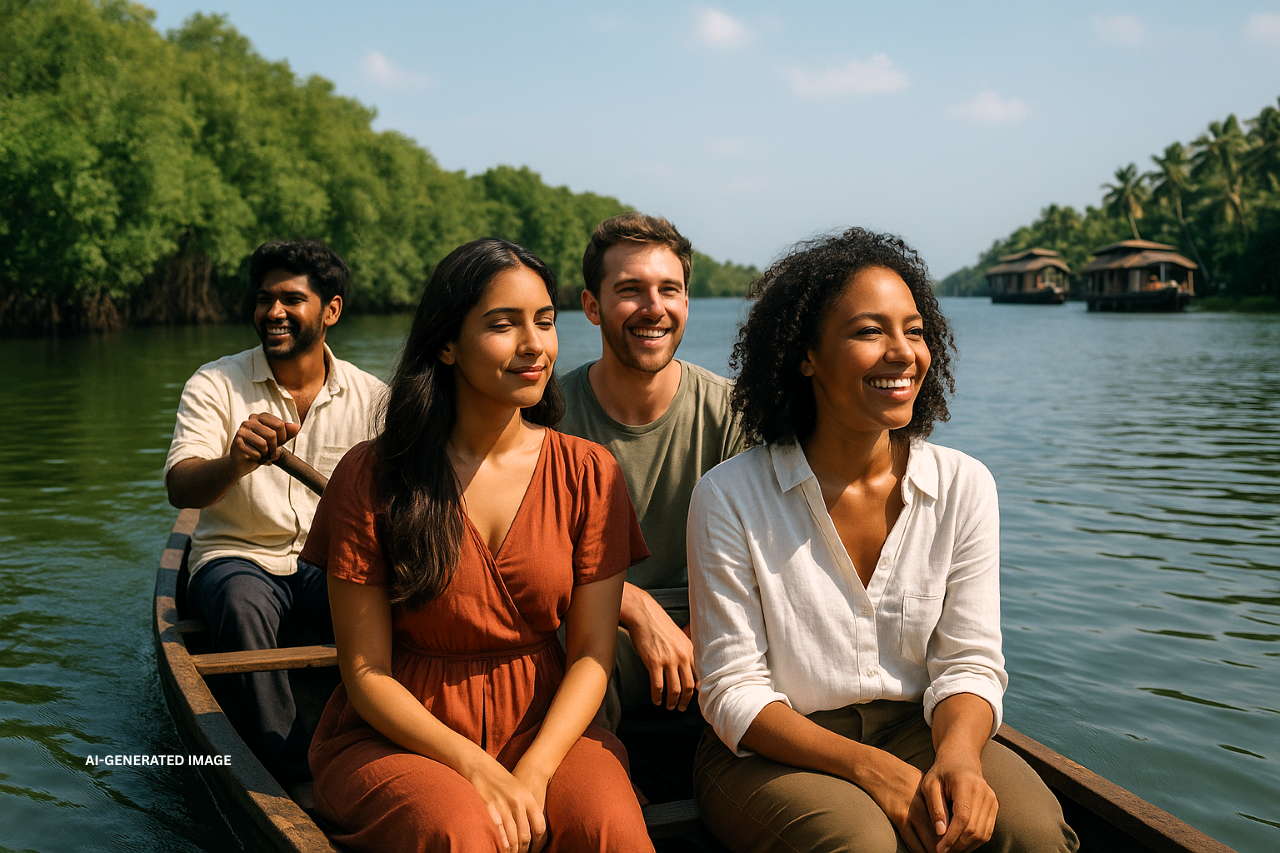
-
Highlights:
-
The Kumarakom Bird Sanctuary, home to herons, kingfishers, and migratory Siberian cranes.
-
Luxury resorts offering Ayurvedic wellness therapies.
-
Canoe rides through mangrove forests.
-
-
Why Visit:
-
Kumarakom is ideal for travelers who enjoy nature, birdwatching, and relaxing in serene surroundings.
Kollam – Gateway to the Southern Backwaters
Kollam, one of Kerala’s oldest seaports, is the starting point of the southern backwater network, dominated by Ashtamudi Lake.
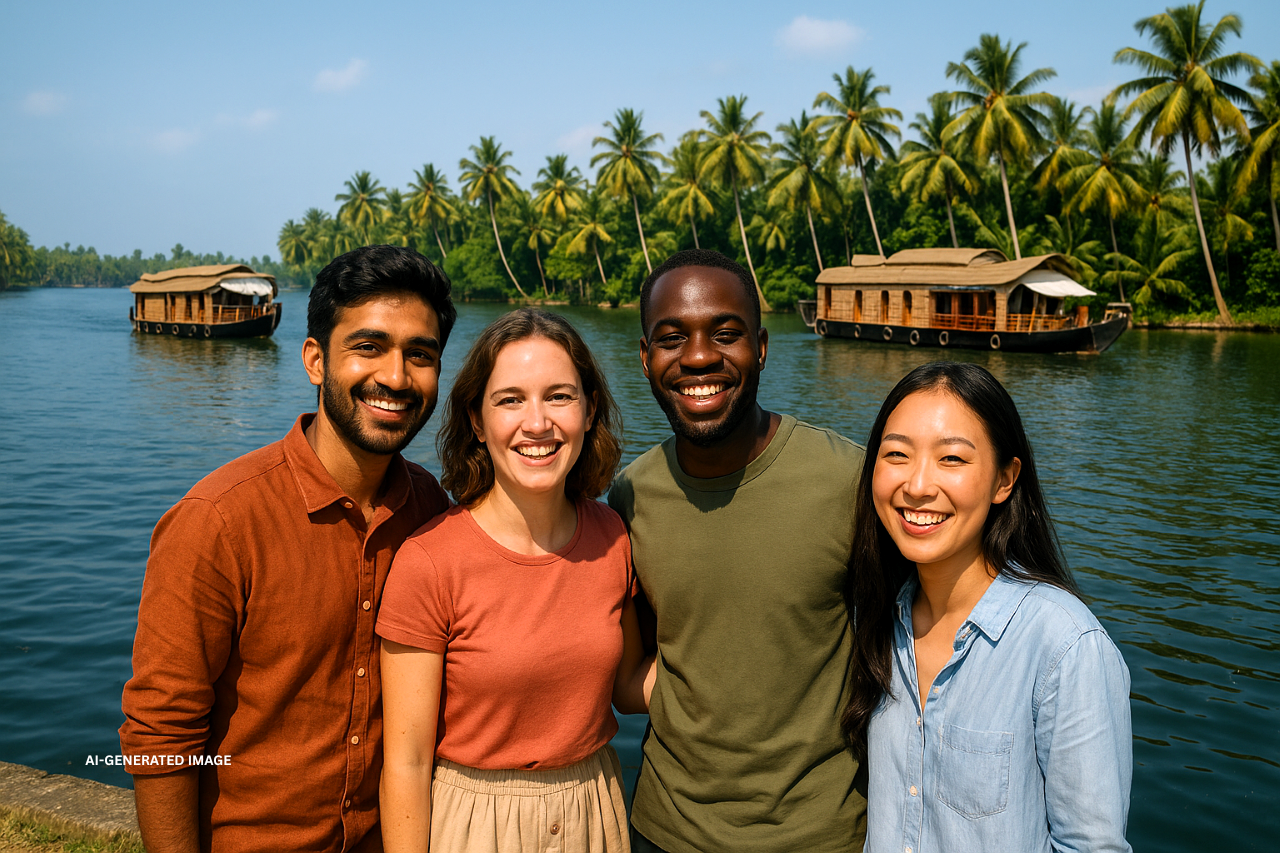
-
Highlights:
-
Full-day cruises linking Kollam to Alleppey.
-
Historical landmarks such as Thangassery Lighthouse.
-
Visits to cashew plantations and traditional markets.
-
-
Why Visit:
-
Kollam offers a quieter, more authentic alternative to Alleppey while still providing spectacular backwater experiences.
Kuttanad – The Rice Bowl of Kerala
Kuttanad is one of the very few regions in the world where farming is carried out below sea level. Its vast paddy fields surrounded by waterways make it one of Kerala’s most unique destinations.
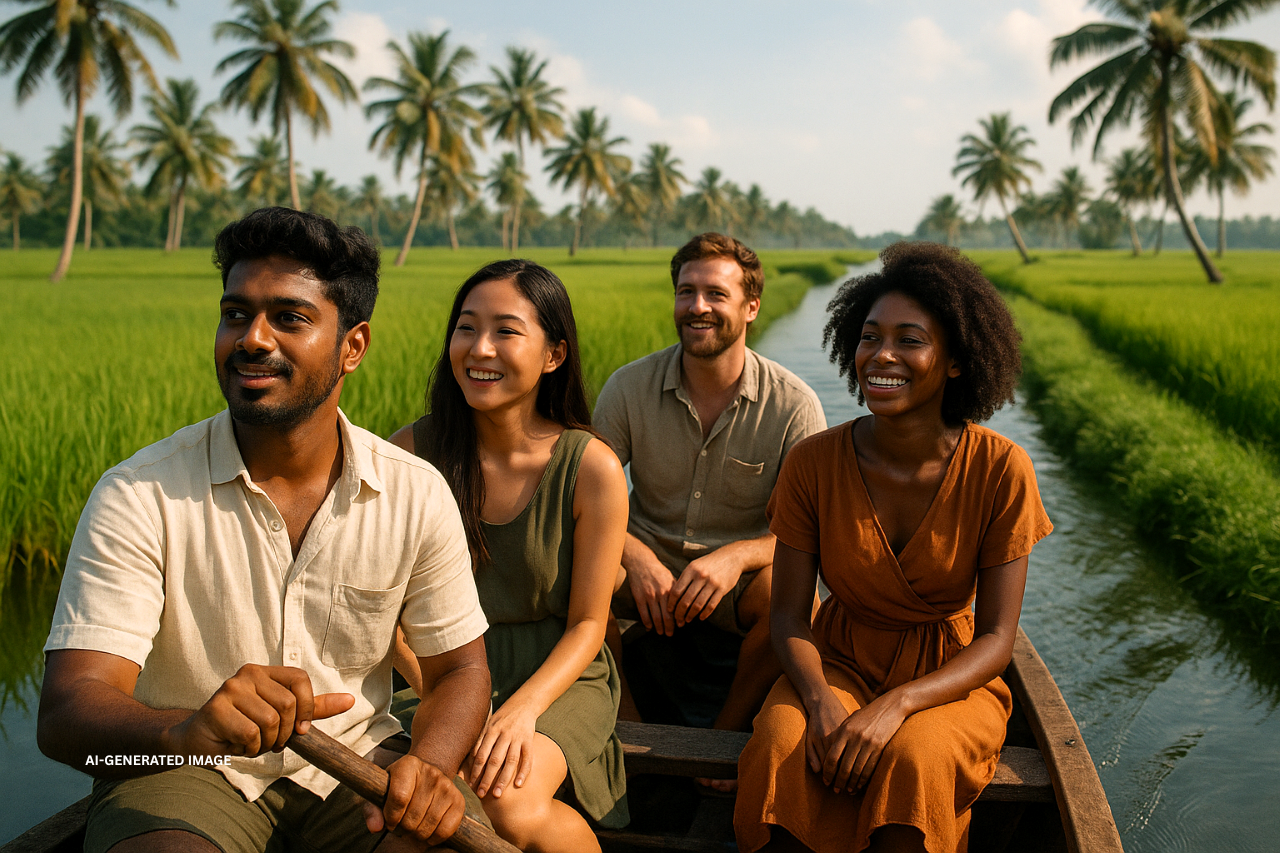
-
Highlights:
-
Extensive rice cultivation and innovative water-management systems.
-
Picturesque canoe rides through narrow canals.
-
Rural lifestyle centered on agriculture and fishing.
-
-
Why Visit:
-
A great option for travelers seeking to explore authentic Kerala village life.
Kochi (Cochin) – Where History Meets Nature
Known as the “Queen of the Arabian Sea,” Kochi blends colonial heritage with the charm of the backwaters. While primarily a cultural destination, it also connects to smaller backwater channels.
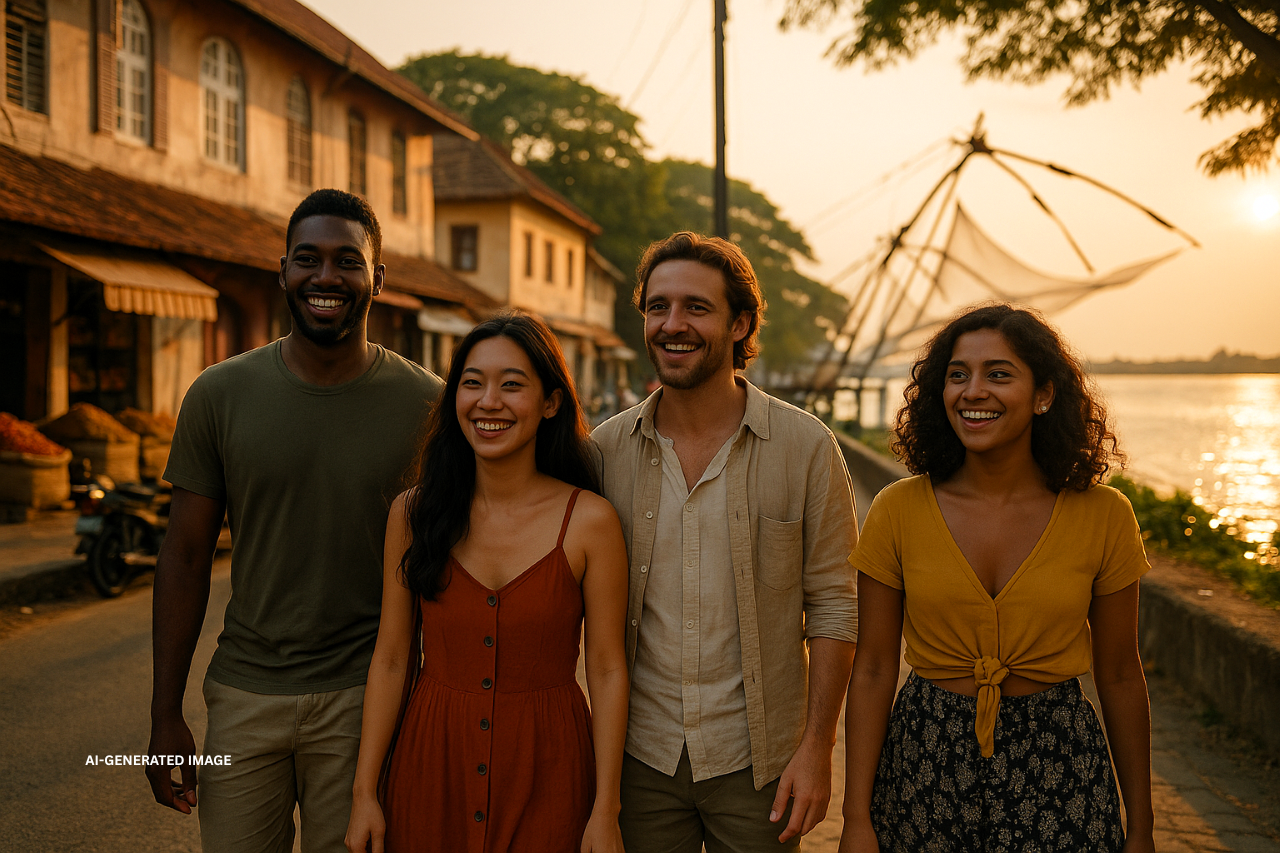
-
Highlights:
-
Fort Kochi with Portuguese, Dutch, and British architecture.
-
The iconic Chinese fishing nets.
-
Spice markets and Kathakali dance performances.
-
-
Why Visit:
-
Kochi is perfect for those who want to combine backwater excursions with history, art, and culture.
Kasargod – A Hidden Treasure
Located in northern Kerala, Kasargod remains relatively untouched compared to the southern backwaters.
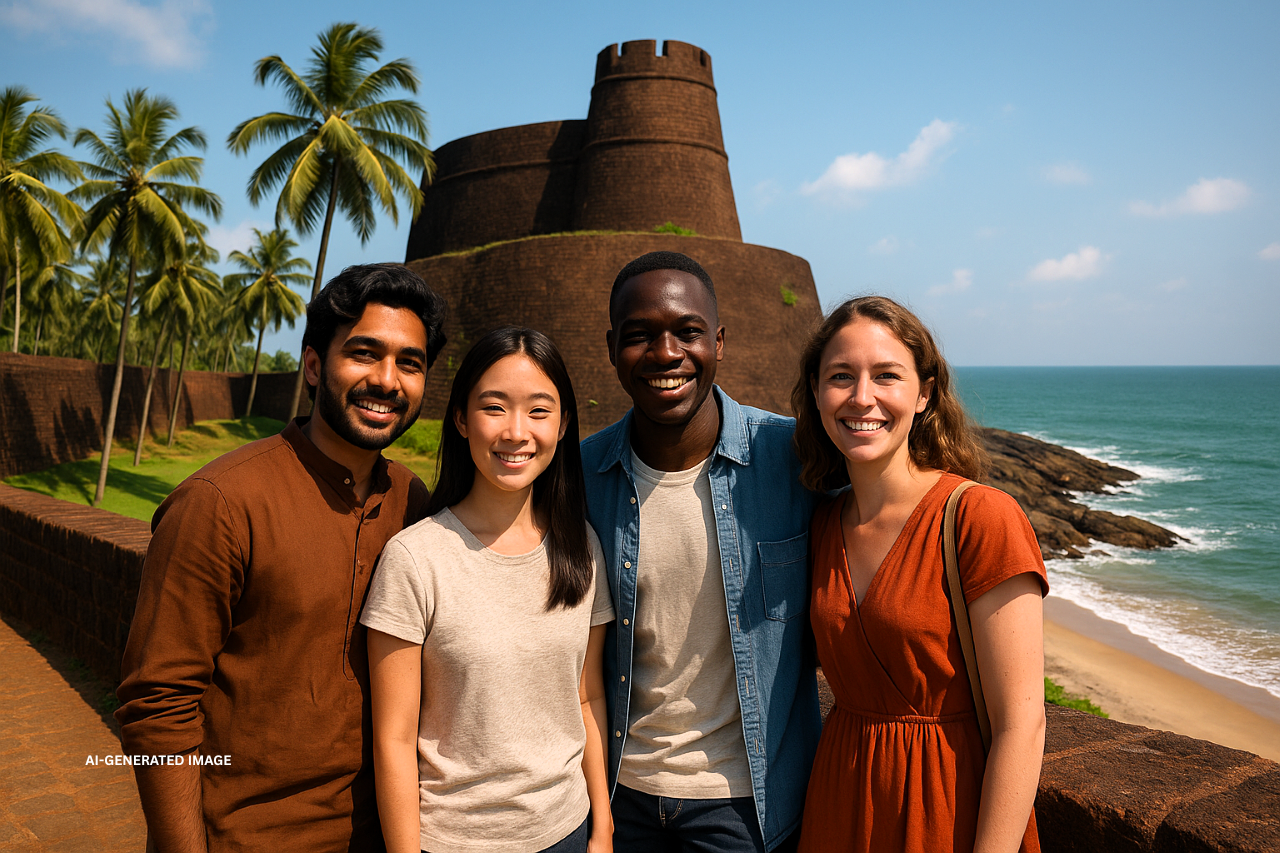
-
Highlights:
-
The historic Bekal Fort, overlooking the Arabian Sea.
-
Serene, unspoiled backwaters surrounded by coconut groves.
-
Distinctive Malabar cuisine.
-
-
Why Visit:
-
Ideal for travelers seeking an off-the-beaten-path experience in Kerala.
Hidden Villages and Lesser-Known Gems
In addition to popular towns, small villages enhance the charm of Kerala travel:
-
Munroe Island:
-
Famous for canoe rides and mangrove forests.
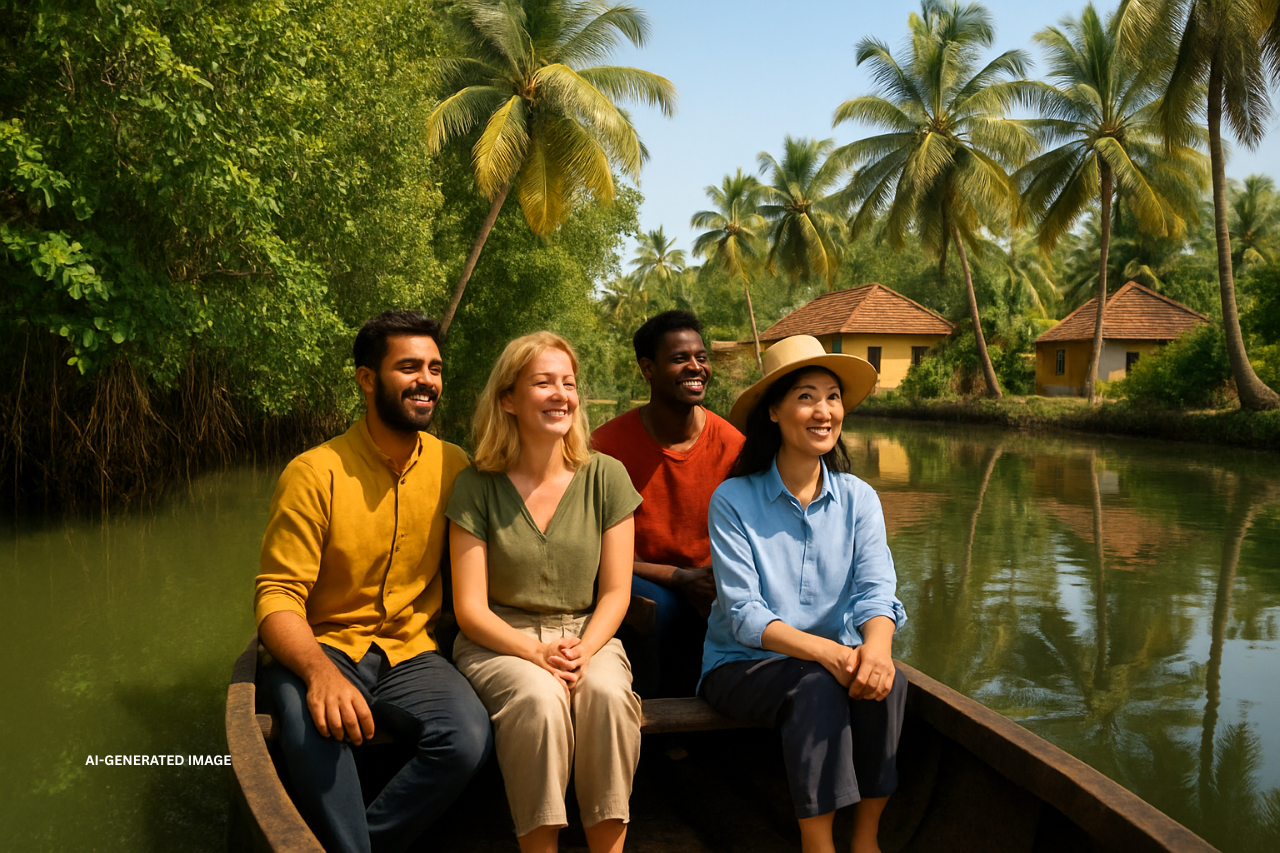
-
Champakulam:
-
Known for its centuries-old church and boat-building traditions.
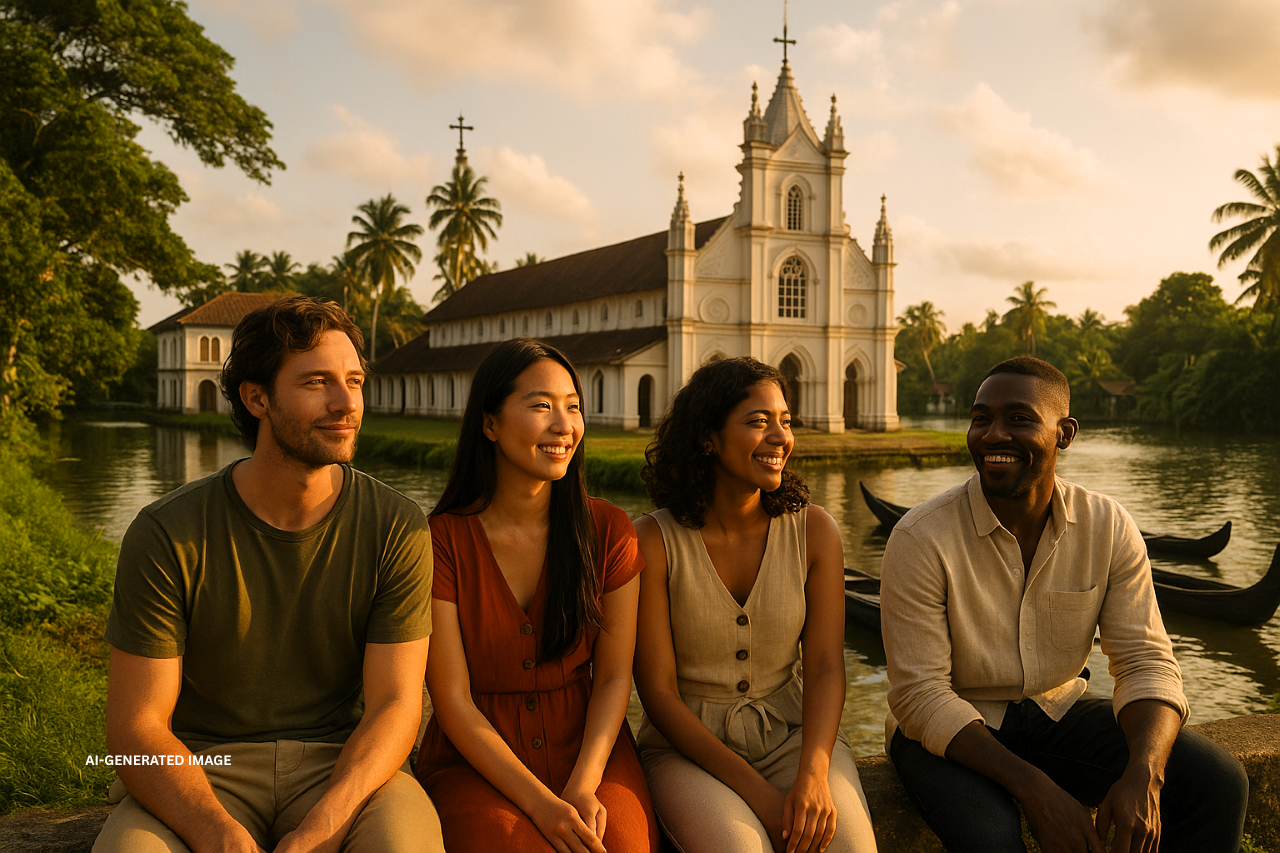
-
Nedumudy:
-
A peaceful village offering authentic homestay experiences.
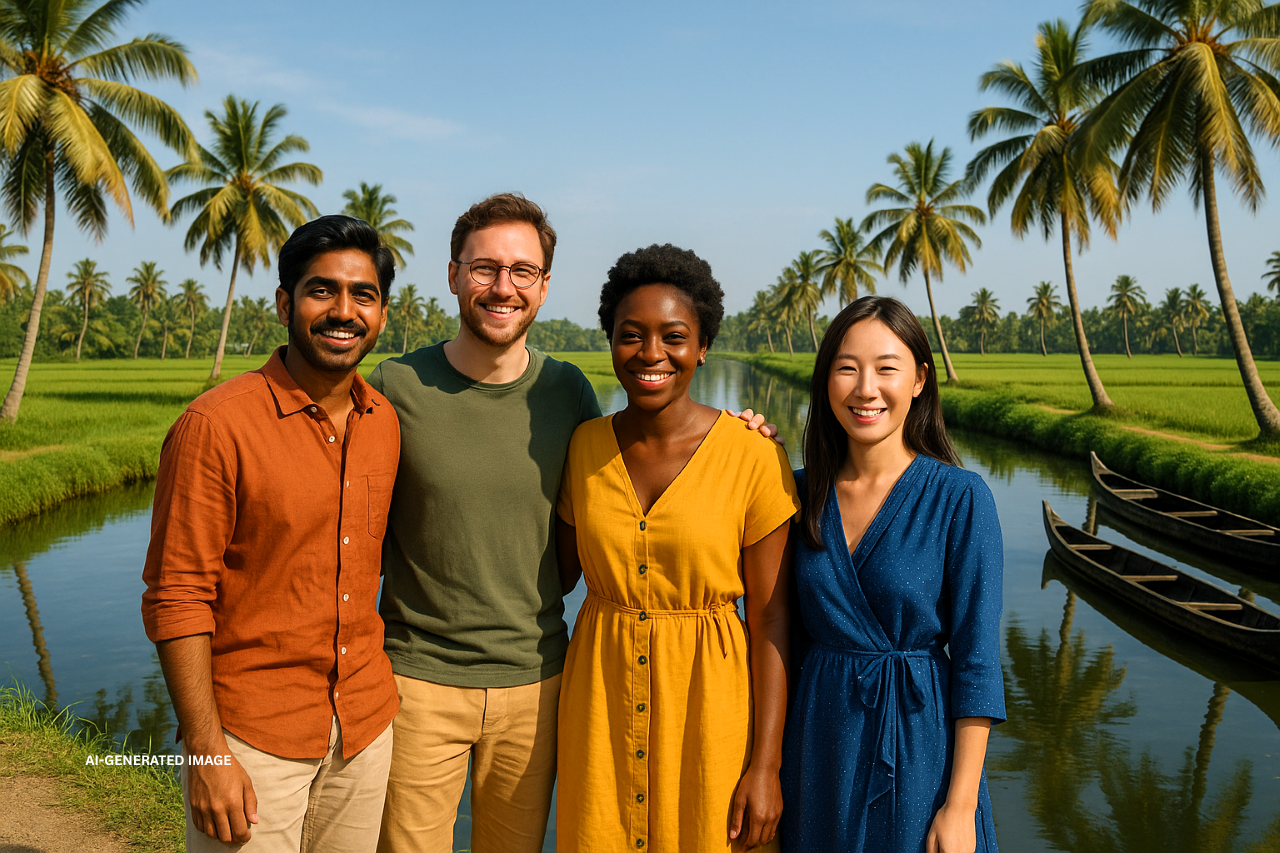
Houseboat in Kerala
A visit to the Kerala backwaters is incomplete without spending time on a houseboat. Known as Kettuvallams, these boats were once used to transport rice and spices. Today, they are converted into floating hotels that offer a perfect balance of tradition and comfort.
Unique Features of Kerala Houseboats
-
Constructed from wood and coir ropes, traditionally without nails.
-
Equipped with bedrooms, dining spaces, and sun decks.
-
Decorated with local designs but furnished with modern amenities such as air-conditioning and private bathrooms.
What to Expect on a Houseboat
-
Overnight Cruises:
-
Relax under a starlit sky while drifting across Vembanad Lake.
-
Traditional Meals:
-
Enjoy local dishes like Karimeen Pollichathu (pearl spot fish wrapped in banana leaves) and appam with stew.
-
Panoramic Views:
-
Watch lush fields, coconut groves, and village life from your deck.
-
Romantic Atmosphere:
-
Houseboats are especially popular with honeymooners.
Types of Houseboats Available
-
Budget Houseboats:
-
Simple accommodations with basic amenities.
-
Mid-Range Houseboats:
-
Comfortable, air-conditioned rooms suitable for families.
-
Luxury Houseboats:
-
High-end facilities, including jacuzzis, spacious lounges, and upper decks.
Booking Tips for Houseboats
-
Book Early:
-
Especially during the winter tourist season (Nov–Feb).
-
Confirm Inclusions:
-
Ensure meals, sightseeing, and air-conditioning are part of your package.
-
Choose Licensed Operators:
-
Always book with recognized companies endorsed by Kerala Tourism.
-
Online vs Local Booking:
-
Online platforms guarantee availability, while local agents sometimes offer last-minute discounts.
Eco-Friendly Houseboat Tourism
Sustainability is crucial for preserving the fragile ecosystem of the backwaters. As a responsible traveler, you can:
-
Select eco-certified houseboats with proper waste management.
-
Avoid plastic bottles and single-use items.
-
Support operators using solar energy and bio-toilets.
Experiences Beyond Houseboats
Although staying on a houseboat in Kerala is the most iconic way to experience the backwaters, many other activities allow travelers to explore the region more intimately. From canoe rides to Ayurvedic retreats, the backwaters offer diverse experiences beyond cruising.
Canoe and Shikara Rides
Canoes and shikaras (small wooden boats) are perfect for navigating narrow canals where larger houseboats cannot enter. These rides bring you closer to daily life along the waterways—children rowing to school, farmers carrying produce, and fishermen casting nets. They are ideal for travelers seeking authentic glimpses of life in the Kerala backwaters.
Village Life Experiences
Exploring villages along the backwaters immerses visitors in Kerala’s rural traditions.
-
Coir Making:
-
Watch locals skillfully spin coconut husks into ropes and mats.
-
Toddy Tapping:
-
Learn how locals extract palm wine from coconut trees.
-
Fishing Practices:
-
See traditional Chinese fishing nets and hand-woven nets in action.
These experiences reflect how strongly the communities here depend on the waterways for survival and culture.
Ayurvedic Wellness Retreats
Kerala is considered the home of Ayurveda, and many backwater resorts offer authentic treatments. Monsoon is believed to be the best season for detox therapies, but Ayurvedic massages, herbal treatments, and yoga are available year-round. These retreats combine wellness with the serene atmosphere of the backwaters, making them popular among international travelers.
Festivals and Snake Boat Races
The backwaters also serve as a cultural stage. The most famous event is the Nehru Trophy Boat Race, held in Alleppey every August. Dozens of rowers propel long snake boats to the rhythm of traditional songs, creating a vibrant spectacle. Smaller festivals, temple rituals, and village fairs further enrich the cultural experience of Kerala travel.
Kerala Itinerary Suggestions
A well-structured Kerala itinerary ensures you enjoy the best of the backwaters within the time you have. Here are sample itineraries for short and extended visits:
3-Day Itinerary – Quick Backwater Escape
-
Day 1:
-
Arrive in Kochi → explore Fort Kochi, spice markets, and a Kathakali performance.
-
Day 2:
-
Travel to Alleppey → enjoy an overnight houseboat cruise.
-
Day 3:
-
Morning canoe ride in a nearby village → return to Kochi for departure.
5-Day Itinerary – Classic Backwater Journey
-
Day 1:
-
Explore Kochi’s cultural heritage.
-
Day 2–3:
-
Cruise and stay overnight on a houseboat in Alleppey.
-
Day 4:
-
Visit Kumarakom for birdwatching and eco-resort relaxation.
-
Day 5:
-
Explore Kuttanad’s paddy fields before heading back.
7-Day Itinerary – Extended Experience
-
Day 1:
-
Tour Kochi’s historic attractions.
-
Day 2:
-
Houseboat in Alleppey with traditional meals.
-
Day 3:
-
Canoe ride and eco-stay in Kumarakom.
-
Day 4:
-
Explore Kollam and cruise on Ashtamudi Lake.
-
Day 5:
-
Village immersion in Kuttanad.
-
Day 6:
-
Canoe rides at Munroe Island and local cultural activities.
-
Day 7:
-
Return to Kochi for shopping, dining, and departure.
These itineraries combine houseboat cruises, village life, and cultural highlights to ensure a balanced Kerala travel experience.
Kerala Travel Tips
To make your journey through the Kerala backwaters smooth and enjoyable, here are some essential travel tips:
Getting There
-
Air:
-
Kochi International Airport and Trivandrum Airport are the main gateways.
-
Rail:
-
Major railway stations include Alleppey, Kollam, and Kottayam.
-
Road:
-
Kerala has excellent highways connecting backwater towns.
Visa and Entry Requirements
International travelers can apply for an Indian e-Visa, available for short visits (30 days to 1 year). Always check the latest requirements before booking.
Budget and Costs
-
Houseboats:
-
Budget ($70–100/night), mid-range ($120–200), luxury ($300+).
-
Food:
-
Local meals cost around $3–5; resorts are higher.
-
Transport:
-
Auto-rickshaws and buses are affordable for local travel.
Local Cuisine to Try
-
Karimeen Pollichathu:
-
Pearl spot fish wrapped in banana leaves.
-
Appam with stew:
-
A Kerala staple made with rice pancakes and vegetable or meat stew.
-
Puttu with kadala curry:
-
Steamed rice cake served with chickpea curry.
-
Toddy (kallu):
-
A mildly alcoholic drink tapped from coconut palms.
Packing Essentials
-
Light cotton clothing for hot, humid weather.
-
Sunscreen, hats, and mosquito repellent.
-
Comfortable sandals and a power bank for long boat trips.
Safety Precautions
-
Always book licensed houseboats for safety and reliability.
-
During the monsoon, check weather conditions before boat rides.
-
Be respectful of local customs, especially when visiting villages and temples.
Culture & Lifestyle Around the Backwaters
The beauty of the Kerala backwaters extends beyond their natural landscapes to the vibrant culture and lifestyle of the communities that live along the waterways. These villages are living examples of how tradition and daily life are deeply connected to nature.
Everyday Village Life
Life along the backwaters moves at a gentle pace. Canoes serve as school buses for children, farmers use boats to transport crops, and fishermen cast nets at sunrise and sunset. Women can often be seen washing clothes or cleaning vegetables on the steps that lead down to the canals. The backwaters also support cottage industries such as coir production, where coconut husks are processed into ropes, mats, and handicrafts.
Spiritual Diversity and Harmony
Kerala is well known for its religious diversity, and the backwaters are no exception:
-
Hindu temples host colorful rituals and festivals.
-
Ancient churches, like the St. Mary’s Forane Church in Champakulam, showcase Kerala’s Christian heritage.
-
Mosques along the waterways reflect the traditions of coastal Muslim communities.
This coexistence highlights the inclusive spirit that defines Kerala travel.
Cultural Expressions
-
Kathakali Performances:
-
Classical dance dramas with elaborate makeup and storytelling.
-
Vanchipattu (Boat Songs):
-
Sung during snake boat races, adding rhythm and energy to the competition.
-
Theyyam Rituals:
-
Performed mainly in northern Kerala, blending dance, drama, and spirituality.
Together, these traditions create an immersive cultural backdrop for visitors exploring the Kerala backwaters.
Sustainable & Responsible Tourism
The popularity of the Kerala backwaters has boosted the economy but also placed pressure on fragile ecosystems. Sustainable tourism is therefore essential to protect this natural treasure.
Challenges from Tourism
-
Pollution from untreated waste and fuel emissions by poorly managed boats.
-
Overcrowding during peak tourist seasons, especially in Alleppey.
-
Biodiversity Threats from overfishing and unchecked development.
Initiatives for Sustainability
-
The Kerala Responsible Tourism Mission promotes eco-friendly travel and community involvement.
-
Eco-houseboats now use solar panels, bio-toilets, and improved waste management systems.
-
Village tourism programs ensure that local families directly benefit from tourism revenue.
How Travelers Can Help
Travelers can contribute to sustainability by:
-
Choosing licensed and eco-certified houseboats.
-
Carrying reusable bottles and avoiding single-use plastics.
-
Supporting local artisans, homestays, and farmers.
-
Traveling in small groups to reduce environmental impact.
By making mindful choices, visitors can ensure that the Kerala backwaters remain pristine for future generations.
Conclusion
The Kerala backwaters are more than just a scenic escape—they represent the harmony between people and nature. Whether it’s sailing on a houseboat, exploring paddy fields in Kuttanad, or watching a lively snake boat race, every experience reveals a different side of Kerala’s charm.
The best time to visit Kerala is during the winter months for pleasant weather, though the monsoon season paints the backwaters in lush green and offers a unique appeal. With countless places to see in Kerala, from Alleppey’s lively canals to Kumarakom’s bird sanctuary, travelers can create a Kerala itinerary that suits their interests—romance, adventure, culture, or wellness.
Ultimately, the backwaters invite you to slow down, embrace simplicity, and experience Kerala at its most authentic. Whether you are a honeymooner, a family, or a solo traveler, the memories you create here will last a lifetime.
FAQs
What are the Kerala backwaters known for?
They are famous for their houseboat cruises, lush paddy fields, serene canals, and traditional village life.
How many days should I spend exploring the backwaters?
A short 2–3 day trip is enough for a houseboat stay, while a 5–7 day Kerala itinerary allows you to explore multiple destinations.
What is the best time to visit Kerala backwaters?
November to February is the most pleasant, but the monsoon season offers lush landscapes and a quieter atmosphere.
Are houseboats in Kerala safe?
Yes, provided you book with licensed operators approved by Kerala Tourism.
How much does a houseboat in Kerala cost?
Budget boats start at around $70 per night, mid-range options range from $120–200, and luxury houseboats can cost $300 or more.
Can families with children stay on a houseboat?
Yes, most houseboats are family-friendly and equipped with safety features.
Which is better: Alleppey or Kumarakom?
Alleppey is ideal for houseboat cruises, while Kumarakom is perfect for resorts and birdwatching.
Can I book a Kerala houseboat online?
Yes, bookings can be made through Kerala Tourism and other trusted platforms.
Do houseboats have Wi-Fi?
Luxury houseboats often provide Wi-Fi, but budget options may not.
Is visiting the Kerala backwaters worth it for international travelers?
Absolutely. It’s a once-in-a-lifetime experience that combines nature, culture, and hospitality.
